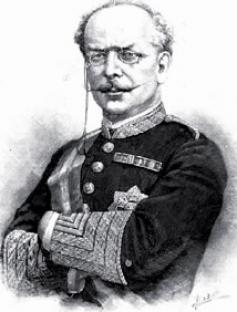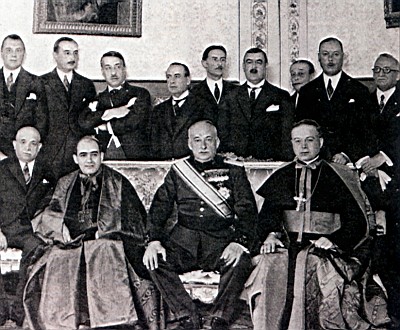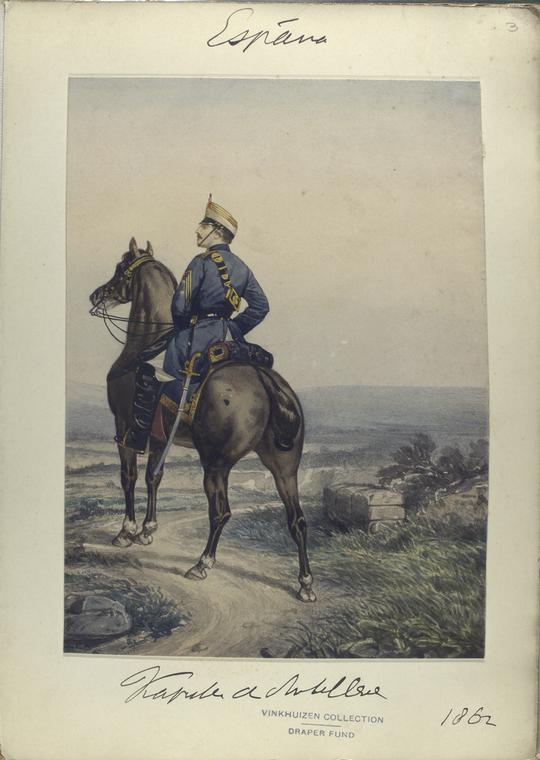
January 1919. Abdel El Krim was alarmed by the appearance of Spanish agents in Beni Waryaghil territory and was determined to fight for tribal independence.
 The following year, Abd el-Krim, together with his father and brother, began a war of rebellion against the Spanish.His goal was now to unite the tribes of the Rif into an independent Republic of the Rif.
The following year, Abd el-Krim, together with his father and brother, began a war of rebellion against the Spanish.His goal was now to unite the tribes of the Rif into an independent Republic of the Rif. Soon afterwards, Abd el-Krim directed his forces to attack the Spanish lines at Annual (Morocco) with great success — in three weeks 8,000 Spanish troops were killed, and the Spanish Army of 13,000 was forced to retreat to the coast by only 3,000 Rifains.
Soon afterwards, Abd el-Krim directed his forces to attack the Spanish lines at Annual (Morocco) with great success — in three weeks 8,000 Spanish troops were killed, and the Spanish Army of 13,000 was forced to retreat to the coast by only 3,000 Rifains.  annual
annualDuring the attack on Annual, General Silvestre either committed suicide or was killed defending the post. This colossal victory established Abd el-Krim as a genius of guerrilla warfare.
 britains?
britains?The embarrassing defeat of Spanish forces at Annual created a political crisis that subsequently led to General Miguel Primo de Rivera's coup d'état of September 13, 1923,
the installation of a military dictatorship (1923–1930), and the eventual collapse of the Spanish Monarchy in April 1931.Below is the dictator with his friends from the vatican.

By 1924, the Spanish had been forced to retreat to their possessions along the Moroccan coast. France, which in any case laid claim to territory in the southern Rif, realized that allowing another North African colonial power to be defeated by natives would set a dangerous precedent for their own territories,

HOW IT BEGAN
Over the summer of 1893 a period of renewed agitation by the locals in Melilla Morrocco enabled García y Magallo to secure the funds for the expansion of fortifications surrounding the city. Construction was pushed forward as fast as possible, the main effort being to erect new redoubts at Peuta de Cabiza and Punta Dolossos.

Morocco1863 by delacroix
Siege of Melilla
After a period of escalating violence the war began in earnest on October 3 when 6,000 Rif warriors armed with Remington rifles descended from the mountains and attacked the city's garrison of 400 regular infantry.

The Spaniards fought a bloody daylong battle without relief, losing 21 dead and 100 wounded, while the citizens of Melilla fled to the citadel. Although a civilian corps was organized to aid in the defence, the weight of the attackers, whose ranks were swelled by tribesmen from the hills, compelled the last of the defenders to retire to the fortress.

Lacking any form of heavy weaponry, the Rif tried to take the citadel by storm, charging up the road ways and scaling the walls. Foreign observers described it as an act of gallant fury, but doomed to failure. The Spaniards held the ramparts with the bayonet and their gunfire swept the attackers from the walls.
For the first time, Spanish soldiers wielded their formidable 7 mm Mauser Model 1893's, made famous a few years later at the Battle of San Juan Hill.
 The Rif dead fell in heaps, to the number of 160. Spanish artillery was brought forward and used to good effect to bombard the Rif assembling in neighbouring villages, but when an unlucky cannonade demolished a mosque outside of the city, the Rif effort took on the character of a jihad. Moroccans across the province, whatever their earlier sympathies, rushed to arms against Spain. By October 5 the native force numbered perhaps 12,000, some reports putting its strength as high as 20,000 infantry and 5,000 cavalry.
The Rif dead fell in heaps, to the number of 160. Spanish artillery was brought forward and used to good effect to bombard the Rif assembling in neighbouring villages, but when an unlucky cannonade demolished a mosque outside of the city, the Rif effort took on the character of a jihad. Moroccans across the province, whatever their earlier sympathies, rushed to arms against Spain. By October 5 the native force numbered perhaps 12,000, some reports putting its strength as high as 20,000 infantry and 5,000 cavalry.
[edit] Spanish response
.News of the attack brought war fever to Spain. The government dispatched the ironclad Numancia and two gunboats stationed at Málaga, put the fleet on alert, and mobilized the Army of Andalusia for service abroad. Newspapers and patriotic citizens of every stripe clamoured for vengeance at whatever cost in blood or treasure. The troops mobilizing to bolster Melilla's garrison, initially numbering about 3,000, received in many cities ceremonies and ovations from the populace as they moved to the ports.

From the outset Sultan Hassan recognized Spanish grievances and reaffirmed Spain's right to pursue construction of field works for its own protection. However, his reluctance to cooperate in pacifying his own subjects infuriated the Spanish government and people, who found themselves committed to military operations far exceeding their modest financial resources, on account, they believed, of Moroccan negligence.

On October 4 Numancia shelled several villages along the coast. An artillery detachment from Málaga arrived in Melilla that same day. For several weeks the situation stagnated. Juan García y Magallo, Governor of Melilla and commander of the Spanish forces, issued an ineffective ultimatum while the Sultan dispatched a contingent of regular troops under Baja-el-Arbi to restore the situation, without success. Skirmishes were fought at forts Camellos and San Lorenzo. When the Rif tore down the forts they'd captured, Margallo deployed small parties of infantry and workmen to throw up new earthworks at forts Cabrerizas and Rostro Gordo, under cover of the Spanish batteries.

On October 22 the gunboat Conde de Venadito steamed to the mouth of the Ouro, anchored there, and turned her Hotchkiss guns on the Rif. The ship hurled 31 shells at the Rif trenches and returned to Melilla's harbour without sustaining any damage. 5,000 Rifians in turn made a heavy attack on the heights of Sidi Guariach on October 27 and, despite again running afoul the guns of the Venadito and the Spanish batteries, drove General Margallo and General Ortego back into the citadel and seized their half-finished field works.
To dislodge the Rifians from the works near Cabrerizas and Rostro Gordo Margallo rode out on October 28 at the head of a column of 2,000 men. The Rifians in the trenches numbered about 3,000 men; both sides fought with courage but the Rif warriors held the line while their main body flocked 6,000 reinforcements to the battle. With this numerical superiority the Rif fighters extended their line in an attempt to envelop Margallo's Spaniards. The general, thinking he saw the enemy centre weaken, led a charge against the Rifian trenches and was thrown back with heavy losses.

Margallo sounded a retreat. He was shot dead moments later and his detachment collapsed. The Spanish Army admitted to at least 70 men killed and 122 wounded that day; actual losses were probably much higher. Only General Ortega's rearguard actions kept the retreat from becoming a rout.

No comments:
Post a Comment